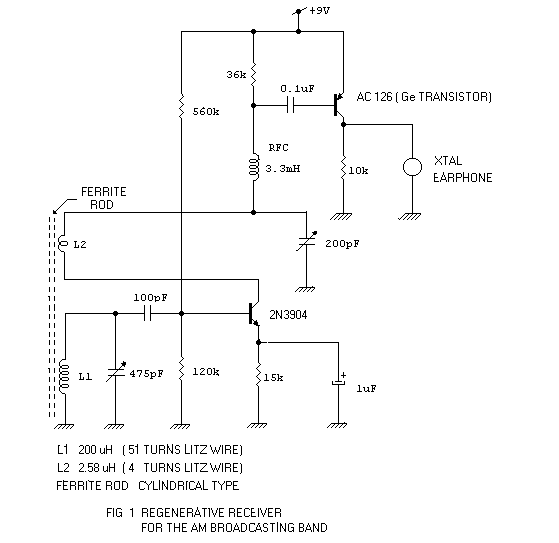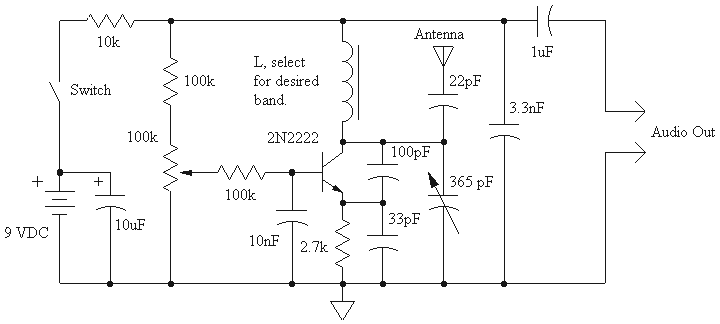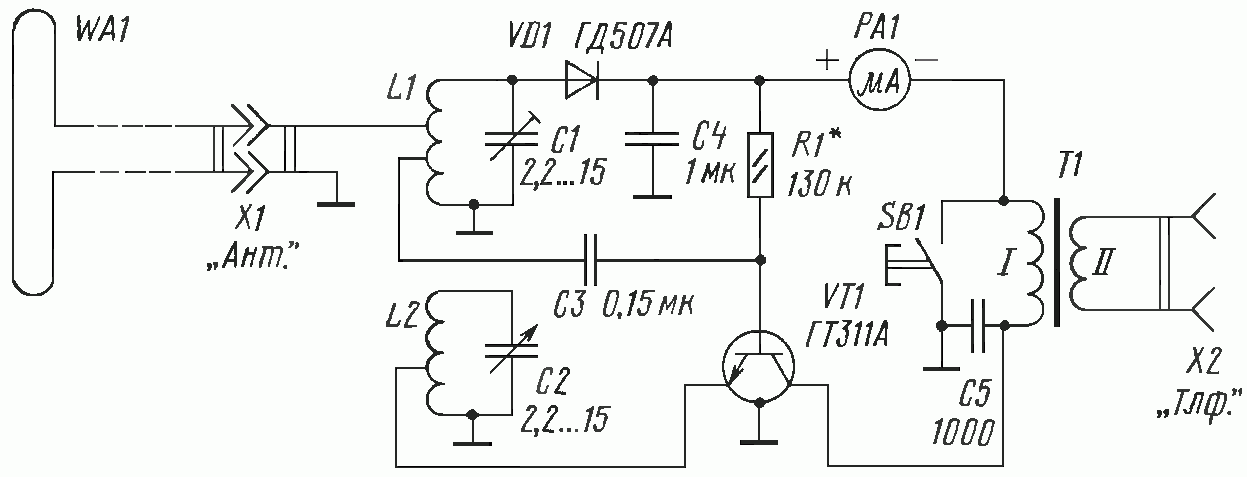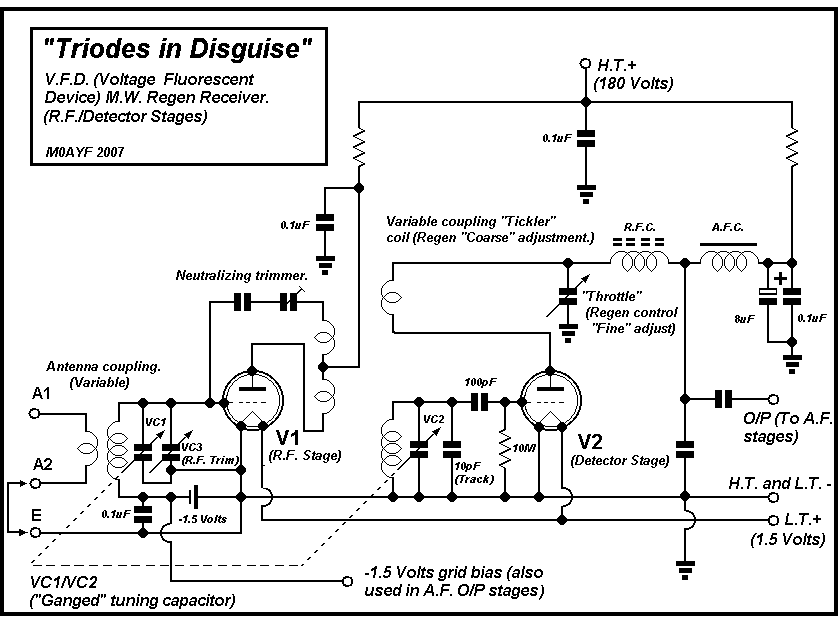
Regenerative Receivers
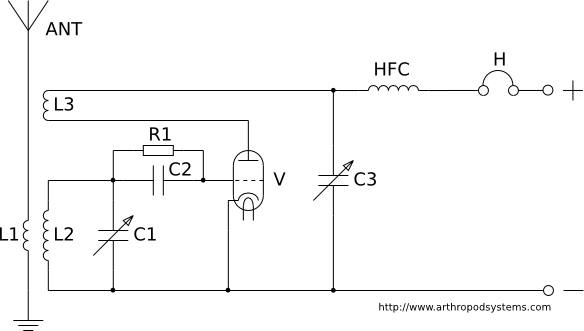
This page discusses various regenerative receiver circuits that were utilized primarily between the 1920s and 1940s. The connections are illustrated using electron tubes (vacuum tubes or valves), although FET transistors can be substituted with minimal adjustments. For radio enthusiasts, this page may serve as a valuable resource, showcasing different connection configurations for tube-based regenerative receivers. The circuits may also be beneficial for new tube constructions or FET/bipolar transistor implementations. In these circuits, L1 represents the antenna coil, L2 is the main coil, and L3 is the feedback "tickler" coil. Headphones (H) can be replaced with an audio transformer or an appropriate RC combination for connection to the next amplifier stage. In all circuits, R1 is approximately 1 megaOhm, and C2 is around 100 picoFarads.
1. Classic connection - plain inductive reaction: A high-frequency radio signal is coupled from the antenna coil L1 to the main tank circuit L2, with C1 used to select the radio station. A triode is configured as a grid demodulator (audion), and the demodulated audio signal at the anode is transmitted to the headphones (H). Positive feedback is achieved through the tickler coil L3, which feeds back a portion of the high-frequency energy from the anode to the grid circuit (coil L2). The regulation of positive feedback can be adjusted by changing the distance between L2 and L3 or by rotating L3. Coils L2 and L3 must have the correct polarity; if they are wound in the same direction (e.g., clockwise), they should be connected as indicated in the schematic. If positive feedback is not achieved, swapping the ends of L3 may resolve the issue. If it persists, L3 may be too far from L2 or have an insufficient number of turns. For medium wave reception (540 - 1600 kHz), L1 should consist of approximately 5-10 turns, L2 around 80 turns, and L3 40-50 turns of insulated or lacquered copper wire on a cylinder with a 30 mm diameter. If a ferrite core is used instead of an air core coil, a 10 mm cylinder diameter is adequate. C1 should have a maximum capacity of 500 - 1000 pF. The anode voltage should be between 40-80 volts. A noted deficiency is that it can be challenging to create adjustable inductive coupling between L2 and L3. Additionally, any movement of L3 alters their mutual capacitance, necessitating slight adjustments to the main tank circuit (L2 - C1) after each change in regeneration level.
2. Inductive reaction with capacitive regulation (Leithauser connection): In this configuration, feedback regulation is achieved using C3 (with a maximum capacity of 250 - 500 pF). A higher capacity results in lower impedance for high-frequency currents, leading to a stronger reaction. This allows for finer adjustments to the feedback level. Coils L2 and L3 are wound in the same direction and on the same cylindrical form, providing fixed inductive coupling. A high-frequency choke (HFC) with a value of 30 - 40 mH for medium wave is included to prevent high-frequency currents from flowing into the headphones. A noted deficiency is sensitivity to hand capacitance, as the rotor of C3 is not grounded for high-frequency currents. If a hand is moved closer to C3 during adjustment, its capacitance slightly increases, altering the reaction level. This makes it challenging to set the receiver for maximum sensitivity just before oscillations commence.
3. Inductive reaction with capacitive regulation of feedback: In this configuration, the rotor of the reaction capacitor is grounded, significantly reducing the hand capacitance issue present in the previous schematic. However, L2 and L3 cannot be wound in the same manner as in the previous design.
4. Schnell circuit: This circuit features inductive reaction with capacitive feedback regulation, using an adjustable C3 with a maximum capacity of 200 - 300 pF. This setup exhibits minimal sensitivity to hand capacitance, allowing for fine regulation of reaction. Unfortunately, once C3 is adjusted, C1 must be re-adjusted for optimal sensitivity, complicating the precise calibration of the frequency scale.
5. Nestel circuit: This circuit is characterized by good tone quality and low audio distortion, as demodulation occurs in a separate diode. The vacuum triode V2 is configured with negative grid bias, enabling a very soft onset of oscillation.This page covers several different regenerative receiver circuits that were used in the past, mostly from 1920s to 1940s. Connections are shown with electron tubes (vacuum tubes/valves), but FET transistors can be substituted with little or no changes.
To those infected with radio bug, this page might be a useful resource. It shows different conne ction setups for tube based regenerative receivers. As such they might prove useful for new tube builds or FET/bipolar transistor implementations. Throughout, L1 is antenna coil, L2 main coil and L3 feedback "tickler" coil. Headphones H can be replaced with audio transformer or suitable RC combination for connection to next amplifier stage, in all circuits. R1 is around 1 megaOhm, C2 around 100 picoFarads. 1. Classic connection - plain inductive reaction. High frequency radio signal is coupled from antenna coil L1 to main tank circuit L2 - C1 used to select radio station.
Triode is connected as grid demodulator (audion). Demodulated audio signal at anode is sent to headphones H. Positive feedback is achieved with tickler coil L3, feeding back part of high frequency energy from anode to grid circuit (coil L2). Regulation of positive feedback is done by change of L2 <-> L3 distance, or by L3 rotation. Coils L2 and L3 must have proper "polarity". If they are wound in the same direction (say clockwise on coil form) they should be connected as indicated on schematic.
If positive feedback cannot be achieved, try swapping L3 ends. If it still doesn`t work, L3 is too far away from L2, or it has insufficient number of turns. For medium wave 540 - 1600 kHz reception, L1 should have about 5-10 turns, L2 around 80, and L3 40-50 turns of insulated or lacquered copper wire on cylinder with 30 mm diameter. If ferrite is used instead of air core coil, 10 mm cylinder diameter is sufficient. C1 is 500 - 1000 pF maximum capacity variable capacitor. R1 is 1 MegaOhm, C2 is 100 pF. Anode voltage is 40-80 volts. Deficiency: it is somewhat difficult to make adjustable inductive coupling between L2 and L3. Also, whenever L3 is moved closer or farther from L2, their mutual capacitance changes. This means that main tank circuit L2 - C1 has to be sligtly adjusted again after every change in regeneration level.
2. Inductive reaction with capacitive regulation (Leithauser connection). Feedback regulation is now done with C3 (maximum capacity 250 - 500 pF). Higher capacity means less impedance for HF current, and this means stronger reaction. In this way it is possible to change feedback level in much finer way. L2 and L3 are wound in the same direction, and on the same cylindrical form. Their inductive coupling is now fixed. HFC is high frequency choke (30 - 40 mH for MW) which prevents flow of HF currents into headphones. Deficiency: sensitive to hand capacity, because C3 rotor is not grounded for HF currents. If hand is moved closer to C3 for adjustment, its capacity slightly increases, and this changes the reaction level. Because of this, it is hard to adjust receiver for maximum sensitivity (just before oscillations start).
3. Inductive reaction with capacitive regulation of feedback. Rotor of reaction capacitor is now grounded. In this way hand capacity problem of schematic 2 is much reduced. L2 and L3 cannot be wound in the same way (connected together) as in schematic 2, though. 4. Schnell circuit. Inductive reaction with capacitive feedback regulation (adjustable C3, 200 - 300 pF maximum capacity). This circuit has very small sensitivity to hand capacity, and fine reaction regulation is possible. Unfortunately, once C3 is adjusted, C1 has to be re-adjusted for maximum sensitivity. This makes it harder to precisely calibrate frequency scale. 5. Nestel circuit. This circuit has good tone quality and low audio distortion because demodulation is done in separate diode.
Vacuum triode V2 has negative grid bias, which allows very soft onset of oscill 🔗 External reference
1. Classic connection - plain inductive reaction: A high-frequency radio signal is coupled from the antenna coil L1 to the main tank circuit L2, with C1 used to select the radio station. A triode is configured as a grid demodulator (audion), and the demodulated audio signal at the anode is transmitted to the headphones (H). Positive feedback is achieved through the tickler coil L3, which feeds back a portion of the high-frequency energy from the anode to the grid circuit (coil L2). The regulation of positive feedback can be adjusted by changing the distance between L2 and L3 or by rotating L3. Coils L2 and L3 must have the correct polarity; if they are wound in the same direction (e.g., clockwise), they should be connected as indicated in the schematic. If positive feedback is not achieved, swapping the ends of L3 may resolve the issue. If it persists, L3 may be too far from L2 or have an insufficient number of turns. For medium wave reception (540 - 1600 kHz), L1 should consist of approximately 5-10 turns, L2 around 80 turns, and L3 40-50 turns of insulated or lacquered copper wire on a cylinder with a 30 mm diameter. If a ferrite core is used instead of an air core coil, a 10 mm cylinder diameter is adequate. C1 should have a maximum capacity of 500 - 1000 pF. The anode voltage should be between 40-80 volts. A noted deficiency is that it can be challenging to create adjustable inductive coupling between L2 and L3. Additionally, any movement of L3 alters their mutual capacitance, necessitating slight adjustments to the main tank circuit (L2 - C1) after each change in regeneration level.
2. Inductive reaction with capacitive regulation (Leithauser connection): In this configuration, feedback regulation is achieved using C3 (with a maximum capacity of 250 - 500 pF). A higher capacity results in lower impedance for high-frequency currents, leading to a stronger reaction. This allows for finer adjustments to the feedback level. Coils L2 and L3 are wound in the same direction and on the same cylindrical form, providing fixed inductive coupling. A high-frequency choke (HFC) with a value of 30 - 40 mH for medium wave is included to prevent high-frequency currents from flowing into the headphones. A noted deficiency is sensitivity to hand capacitance, as the rotor of C3 is not grounded for high-frequency currents. If a hand is moved closer to C3 during adjustment, its capacitance slightly increases, altering the reaction level. This makes it challenging to set the receiver for maximum sensitivity just before oscillations commence.
3. Inductive reaction with capacitive regulation of feedback: In this configuration, the rotor of the reaction capacitor is grounded, significantly reducing the hand capacitance issue present in the previous schematic. However, L2 and L3 cannot be wound in the same manner as in the previous design.
4. Schnell circuit: This circuit features inductive reaction with capacitive feedback regulation, using an adjustable C3 with a maximum capacity of 200 - 300 pF. This setup exhibits minimal sensitivity to hand capacitance, allowing for fine regulation of reaction. Unfortunately, once C3 is adjusted, C1 must be re-adjusted for optimal sensitivity, complicating the precise calibration of the frequency scale.
5. Nestel circuit: This circuit is characterized by good tone quality and low audio distortion, as demodulation occurs in a separate diode. The vacuum triode V2 is configured with negative grid bias, enabling a very soft onset of oscillation.This page covers several different regenerative receiver circuits that were used in the past, mostly from 1920s to 1940s. Connections are shown with electron tubes (vacuum tubes/valves), but FET transistors can be substituted with little or no changes.
To those infected with radio bug, this page might be a useful resource. It shows different conne ction setups for tube based regenerative receivers. As such they might prove useful for new tube builds or FET/bipolar transistor implementations. Throughout, L1 is antenna coil, L2 main coil and L3 feedback "tickler" coil. Headphones H can be replaced with audio transformer or suitable RC combination for connection to next amplifier stage, in all circuits. R1 is around 1 megaOhm, C2 around 100 picoFarads. 1. Classic connection - plain inductive reaction. High frequency radio signal is coupled from antenna coil L1 to main tank circuit L2 - C1 used to select radio station.
Triode is connected as grid demodulator (audion). Demodulated audio signal at anode is sent to headphones H. Positive feedback is achieved with tickler coil L3, feeding back part of high frequency energy from anode to grid circuit (coil L2). Regulation of positive feedback is done by change of L2 <-> L3 distance, or by L3 rotation. Coils L2 and L3 must have proper "polarity". If they are wound in the same direction (say clockwise on coil form) they should be connected as indicated on schematic.
If positive feedback cannot be achieved, try swapping L3 ends. If it still doesn`t work, L3 is too far away from L2, or it has insufficient number of turns. For medium wave 540 - 1600 kHz reception, L1 should have about 5-10 turns, L2 around 80, and L3 40-50 turns of insulated or lacquered copper wire on cylinder with 30 mm diameter. If ferrite is used instead of air core coil, 10 mm cylinder diameter is sufficient. C1 is 500 - 1000 pF maximum capacity variable capacitor. R1 is 1 MegaOhm, C2 is 100 pF. Anode voltage is 40-80 volts. Deficiency: it is somewhat difficult to make adjustable inductive coupling between L2 and L3. Also, whenever L3 is moved closer or farther from L2, their mutual capacitance changes. This means that main tank circuit L2 - C1 has to be sligtly adjusted again after every change in regeneration level.
2. Inductive reaction with capacitive regulation (Leithauser connection). Feedback regulation is now done with C3 (maximum capacity 250 - 500 pF). Higher capacity means less impedance for HF current, and this means stronger reaction. In this way it is possible to change feedback level in much finer way. L2 and L3 are wound in the same direction, and on the same cylindrical form. Their inductive coupling is now fixed. HFC is high frequency choke (30 - 40 mH for MW) which prevents flow of HF currents into headphones. Deficiency: sensitive to hand capacity, because C3 rotor is not grounded for HF currents. If hand is moved closer to C3 for adjustment, its capacity slightly increases, and this changes the reaction level. Because of this, it is hard to adjust receiver for maximum sensitivity (just before oscillations start).
3. Inductive reaction with capacitive regulation of feedback. Rotor of reaction capacitor is now grounded. In this way hand capacity problem of schematic 2 is much reduced. L2 and L3 cannot be wound in the same way (connected together) as in schematic 2, though. 4. Schnell circuit. Inductive reaction with capacitive feedback regulation (adjustable C3, 200 - 300 pF maximum capacity). This circuit has very small sensitivity to hand capacity, and fine reaction regulation is possible. Unfortunately, once C3 is adjusted, C1 has to be re-adjusted for maximum sensitivity. This makes it harder to precisely calibrate frequency scale. 5. Nestel circuit. This circuit has good tone quality and low audio distortion because demodulation is done in separate diode.
Vacuum triode V2 has negative grid bias, which allows very soft onset of oscill 🔗 External reference
